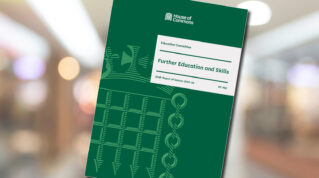Officials have recouped £86 million from colleges and sixth forms since the rollout of T Levels due to overambitious allocations, data errors and “bumpy” policymaking.
The Department for Education clawback, revealed to FE Week through a Freedom of Information request, accounts for more than 16 per cent of the total £523 million revenue funding dished out up to 2024-25.
It means total underspend on the government’s T Levels budget is even higher than what was reported in this year’s National Audit Office report that exposed the extent of flawed forecasting.
Colleges and sector leaders have pointed to a mix of overallocation errors, policy uncertainty, and unmet student recruitment assumptions as the key reasons behind the clawback.
Allocations out of step with predictions
The DfE bases T Level student allocations on estimates submitted by colleges for new starter numbers, plus the number of carry-over learners they have from the previous academic year.
Officials have issued repeated warnings that some T Level providers have “recorded students incorrectly” which means they are placed in the wrong funding bands.
Government funding guidance now includes a message that states: “Making errors in recording your T Level data could have a significant financial impact. It could lead to a larger than expected recovery of funding.”
The DfE told FE Week this was, however, not the main cause for funding recoveries, though it failed to reveal what the main cause was.
Anne Murdoch, senior adviser in college leadership at the Association of School and College Leaders, said she also doubted the “high level of funding clawback is being caused by providers submitting data on student numbers which is incorrect”, adding that schools and colleges have “specialist staff who carry out these processes pretty meticulously”.
Murdoch said the “most likely cause” is providers are “simply not recruiting the number of T Level students that they’re aiming for because of the well-documented problems with attracting young people onto these courses”.
This is “sometimes exacerbated by the government then inflating that target – presumably because there is so much pressure to boost T Level uptake,” she added.
Simon Cook, principal of MidKent College, told FE Week his college received a DfE allocation for 389 T Level students this year, which was “way, way over” their submitted estimate of 282 learners.
The college ended up enrolling 260 learners, meaning it will be hit with a clawback of around £150,000.
Cook, who is yet to receive an explanation for the larger-than-requested allocation from the DfE, said he had heard of similar cases at other colleges.
Policymakers’ meddling
Hartlepool College of Further Education principal Darren Hankey said the government’s wider level 3 reforms, which involve defunding most applied general qualifications (AGQs) like BTECs where they overlap with T Levels, will have also caused overallocation issues.
“When colleges were planning for 2024-25 – sometimes well over a year in advance – it was perfectly clear that A-levels, T Levels and apprenticeships were the only show in town,” Hankey told FE Week.
“Then Labour was elected in July 2024 and froze this qualification change. As a result, lots of colleges continued with their existing level 3 AGQ offer and didn’t progress with shifting students to T Levels. This situation is unsurprising and largely down to policymakers’ meddling.”
It is unclear how widespread overallocation errors are.
Other colleges that spoke to FE Week said their allocations were in line with estimates.
Marianne Flack, deputy principal of Suffolk New College, said: “This has not been our experience, our funding has been accurate and based upon our targets. The DfE also supports us with 16-to-18 in-year growth funding, and as a college with a positive growth trajectory, the in-year growth funding outweighs any clawback for T Levels, so we retain a surplus position.”
An Exeter College spokesperson added: “We have recruited in line with expectations at headline level, but T Level numbers have varied significantly by pathway and have not always aligned with our predictions. We have, therefore, experienced modest levels of clawback.”
Lagged funding to the rescue
The DfE’s decision to move to the lagged funding model, common in other 16-to-19 funding streams, from 2027-28 aims to iron out mismatches between forecasts and allocations.
Cath Sezen, director of education policy at the Association of Colleges, said admin errors happen, and forecasting enrolments in an unpredictable and “bumpy” policy environment had been “quite difficult”.
She added: “I’m not saying colleges are excited about lagged funding, but I think that’s an easier system than trying to predict, and reduces extra administrative burdens.”
True scale of underspend
The DfE had an original budget of £1.94 billion to spend on T Levels to the end of 2024-25 – half for revenue spending and half for capital. In a report published in March, the government’s spending watchdog the NAO said the department only spent £1.25 billion overall – meaning an underspend of £688 million.
But if clawback is taken into consideration, which is £86 million from the revenue pot and £18 million from capital spending, it means the true underspend figure is around £792 million.
Original DfE estimates were for 207,000 young people to start a T Level between 2020 and 2024-25. Actual starts figures were 72 per cent lower at 58,327.
Government data also shows around a third of T Level students drop out each year.
Hankey said T Levels still “struggle to gain traction” due to the demanding nine-week industry placement, “adverse publicity,” and the “rigour” of the qualification being “a stretch for some students”.
The DfE was approached for comment.
















Your thoughts